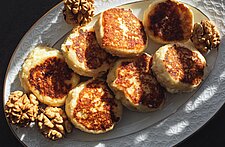Cocktails were mixed, shaken, stirred and discussed at the 11th Annual StarChefs International Chef Conference (ICC) with the main themes centering on vodka – it’s back in more mature, balanced, and complex varieties—and lower ABV concoctions.
The classic cocktail is here to stay, say mixologists, but now more than ever, they’re transforming the usual suspects—mojitos, Negroni's, Manhattans—with their own twists, infusing their own spirits, bitters, shrubs and yes, even surprise ingredients, as a way to up flavor.

According to Chad Arnholt and Claire Sprouse of Tin Roof Drink Community in NYC, you don't have to go to a speakeasy to find a good cocktail anymore. “Restaurant bars are really producing excellent experiences and pushing the traditional mindset of only pairing wine with food,” says Sprouse. “Low ABV cocktails resonate well in this arena because they tend to not overpower the food, are often wine-based and more approachable to wine-drinkers, and aren't as regretful as the old ‘three-martini lunch.’”
Claire Bertin-Lang, the Mixology Director who works behind the scenes at StarChefs, also notes a lower ABV: “I think this is happening because bartenders themselves are moving away from shots and towards more ‘sessionable’ cocktails you can drink without getting too woozy.”
Brandy is another trend Arnholdt and Sprouse see picking up steam. “Cognac has always been the workhorse brandy for the cocktail crowds, but now you're seeing more mixing with Calvados, domestic fruit brandies, Armagnac, and Grap,” she adds.
CLICK HERE to see the Top Food Trends fro 2017 from Starchefs ICC
And then there’s sherry– the two are big fans of it – and cite fortified wines among their favorite ingredients. “Vermouth, aperitifs, sherry, madeira, and so on, appeal to us because they add complexity and acidity without too much of an alcoholic kick,” explains Sprouse. “They're also very easy to mix with simply and on the fly -- you can make a quick vermouth and soda or sherry cobbler without too much prep work and it can be just as unique of an experience as any other bespoke cocktail.”
Lynette Marrero of Drinksat6 in New York City is another one on the sherry bandwagon. At ICC she offered ICC attendees her “Toffee Negroni” made with Bacardi 8 Anos, Aperol Barbadillo, Amontillado Sherry, and Micro Orchids. “Like everyone else, I’m currently hugely obsessed with sherry,” she says. “It’s got this great nuttiness.”
Marrero designed the drink to appear in Shake. Stir. Sip: More than 50 Effortless Cocktails Made in Equal Parts, a new book by Wine Enthusiast Spirits Editor Kara Newman. “I think people are definitely on the hunt for toned down drinks, both at the bar and at home,” says Marrero. “I’m fascinated by this move towards lighter-style cocktails and I think it’s solely driven by customers’ desire to pair lighter cocktails with food.”
Marrero also sees a big drive to regionality. “Mixologists are focusing on different parts of the world,” she explains.
CLICK HERE to see Inspiration from 13 of Europe's Hottest Cocktail Bars
Sake has also upped its game. Arnholt and Sprouse like mixing with it. And Kenta Goto of Manhattan’s Bar Goto is also a fan. He showed off his sake style with a Japanese-style Mojito, aptly named the “Far East Side.” The cocktail included Dassai 50, Tequila, Lemon, Elderflower, Shiso, and Yuzu Bitters. “I took a classic cocktail—the mojito—and offered a twist on the traditional,” he says. “It starts with great sake—the shiso is the citrus and the yuzu is the mint. It’s the most popular drink at the bar, and I think that’s because it’s very approachable.”

And on the topic of approachability, Joaquin Simo of Pouring Ribbons (New York City) created the “Media Noche,” a Negroni comprised of Bacardi 8 Anos, Bonal (apertif), Cynar, and Bitterman’s Xocolatl Bitters. “Cocktails used to be this high volume afterthought,” he says. “Craft cocktails are still king, but now we are seeing these beautiful, dryer options. I love to balance richness with bitters, so there’s this dichotomy of bitter and sweet. It creates these clean, powerful flavors.”
Simo went on to discuss the importance of creating these flavors with solid ingredients. His current favorite? “I love Cynar. It’s this savory version of Campari. It has like 20 ingredients, and one of them is artichoke!”
Bertin-Lang is in agreement that a great cocktail starts with a combination of the perfect ingredients. Her favorite cocktail showcased this year was the Horse Apple by Giuseppe Gonzalez of Suffolk Arms (New York City). “It is only three ingredients—Skyy Citrus Vodka, fresh green apple juice and fresh horseradish—but it is so good.”
So what’s the next big spirit slated for 2017? Berton-Lang thinks it can be summed up on one word—Amaro. “I think we’re going to see a rise in Amaro-based cocktails. There is so much diversity in that category that a lot of brands and bartenders are just now beginning to learn and appreciate.”
Antoinette Bruno, Editor-in-Chief of StarChefs, agrees. In her annual Culinary Trends Report, she dubbed 2016 the year “Amaro goes American.” House Amari programs have popped up across the country, she notes, from the saffron amaro at Spuntino in Long Island, NY, to Project Amaro at Seattle’s Brovo Spirits, to Wildhawk from Bartender Jacques Bezuidenhout in San Francisco—a bar dedicated to vermouth. “Bartenders,” she says, “Are showing off their own forms of self-expression.”
For more trends in cocktails and mixology, CLICK HERE to subscribe to the in-sight newsletter!





